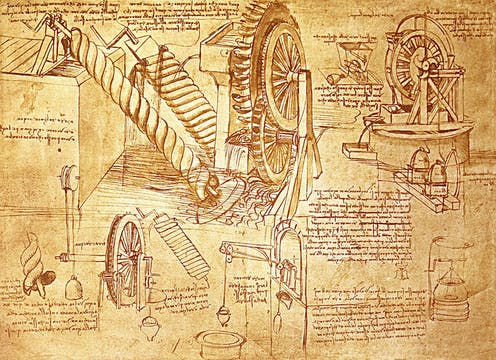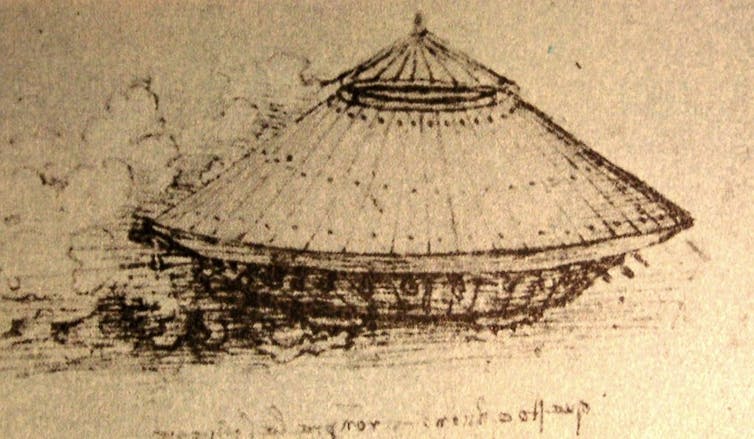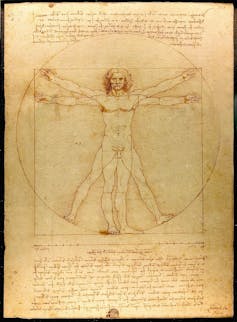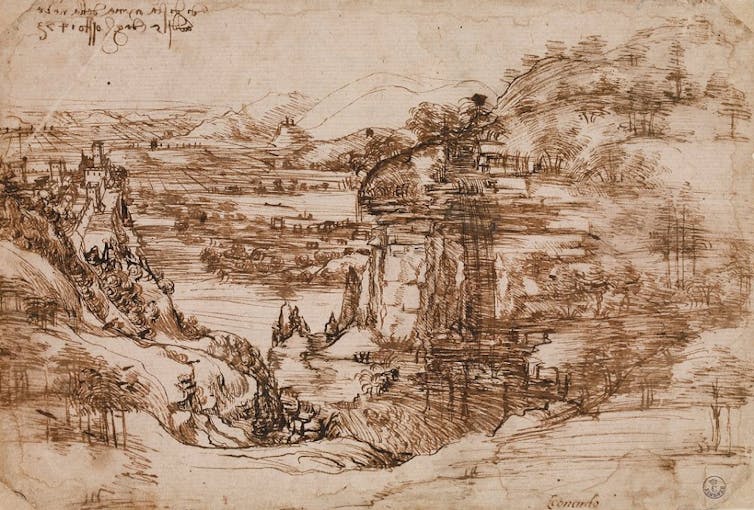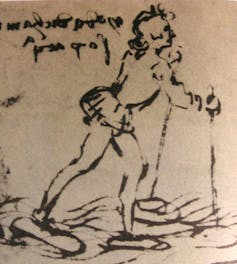Leonardo da Vinci is generally recognised as one of the great figures of the Renaissance and one of the greatest ever polymaths. As the world marks the 500th anniversary of his death, it’s important to look at some of the ways in which he showed that – as well as being a painter, sculptor and engineer – he was a thinker who was way ahead of his time.
Engineering – Dr Hywel Jones
Leonardo da Vinci is renowned as much for his inventions as his works of art, studies of architecture and anatomical drawings. The documents that survive show us his ideas for a wide range of devices. They include some of the first concepts for gliders, helicopters, parachutes, diving suits, cranes, gearboxes and many types of weapons of war. Many of these may be seen in use today, having taken the best part of 400 years to become practical realities.
He combined an imagination ahead of his time, an understanding of the emerging principles of science and engineering, and his superlative draftsmanship to devise new uses for levers, gears, pulleys, bearings and springs. His creations were designed to be useful but also to be appealing to his patrons: the warring dukes and kings of late 15th- and early 16th-century France and Italy.
Da Vinci’s prototype ‘tank’, drawn in the late 15th or early 16th century.
Although he apparently despised war, he was employed for much of the time as a military engineer, devising new defences and concepts for terrifying weapons. His sketches show a prototype “tank” circa 1485, with armour plating and the ability to fire in any direction.
We now know that Leonardo’s “tank”, as drawn, was not practical – it had mistakes in its gearing and would have been so heavy that it could not have manoeuvred. Other weapons, designed to impress and intimidate as much as actually work, included the giant (27-metre) cross-bow, a gun with 33 barrels, ammunition which resembles today’s “cluster bombs”, and the first example of aerodynamically stabilised artillery shells.
His sketches for an “aerial screw” (1486-90) anticipate the idea of the helicopter, although it was not the first demonstration of vertical flight – a Chinese toy with rotors predates this by 1,800 years.
Ornithopters, human powered flying machines which mimicked bird flight, were a fascination for him – and he drew many beautiful and innovative designs. However, bird flight was not fully understood at this time and he was unaware that a human being could never generate the required power to operate such devices.
Leonardo da Vinci’s design for a helicopter, late 15th or early 16th century.
Most of Leonardo’s designs were never built or tested, although modern-day attempts to recreate them have met with mixed success, including some spectacular failures. His imagination was so far ahead of its time that it would take four centuries before ideas such as the tank became practical through the development of light and strong materials, such as steel and aluminium, and new sources of power in the form of engines powered by fossil fuels. He would no doubt recognise – and be fascinated by – much of the machinery of modern life that we take for granted.
Mathematics – Dr Jeff Waldock
Although da Vinci is best known for his artistic works, he considered himself more of a scientist than an artist. Mathematics – in particular, perspective, symmetry, proportions and geometry – had a significant influence over his drawings and paintings, and he was most certainly ahead of his time in making use of it.
Da Vinci used the mathematical principles of linear perspective – parallel lines, the horizon line, and a vanishing point – to create the illusion of depth on a flat surface. In The Annunciation, for example, he uses perspective to emphasise the corner of a building, a walled garden and a path.
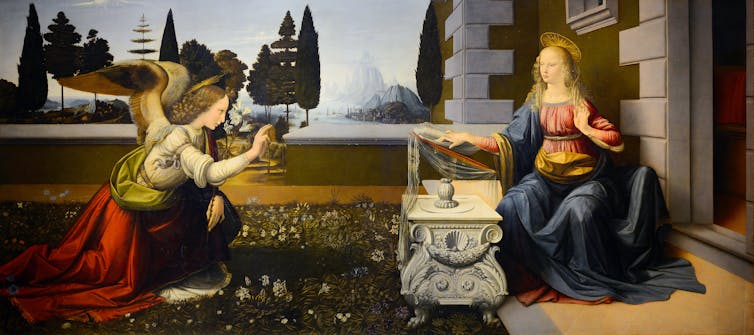
Leonardo da Vinci’s The Annunciation (1472). Galleria degli Uffizi
Leonardo’s Last Supper is a prime example of the use of the mathematics of perspective. The architecture of the building around Jesus and the 12 apostles, as well as lines on the floor beneath the table, create a “vanishing point”, providing a subconscious focal point for the painting.
Leonardo knew of Vitruvius’s work – that with the navel as the centre, a perfect circle could be drawn around a body with outstretched arms and legs. He realised that if arm span and height are related, the person would fit perfectly inside a square. His Vitruvian Man took these observations and attempted to solve the problem of “squaring” a circle. It’s not, in fact, possible to do this exactly (squaring the circle is a metaphor for the impossible), but he managed to come very close.
Leonardo da Vinci’s Vitruvian Man. Luc Viatour / https://Lucnix.be
There exists in mathematics a number, called the “Golden Ratio”, which appears in some patterns in nature – such as the spiral arrangement of leaves. It was first recognised by Luca Pacoli in 1509 that the use of the Golden Ratio led to aesthetically-pleasing images. Da Vinci believed it was critical in providing accurate proportionality, and it underpins the structure of the Mona Lisa.
The importance of mathematics cannot be understated when discussing Leonardo’s later work, and he seems obsessed with these issues; while working on Mona Lisa, for example, Leonardo was reported to be concentrating on geometry, stating: “Let no one read me who is not a mathematician.”
Water – Dr Rebecca Sharpe
Leonardo da Vinci described water as “the vehicle of nature” (vetturale di natura), water being to the world what blood is to our bodies. From his earliest landscape drawings of a river cascading over rocks (1473), to the famous Mona Lisa (1503) and to his final deluge sketches (1517-18), a lot of Leonardo’s paintings featured water.
Landscape drawing for Santa Maria della Neve. https://www.leonardodavinci.net
He was not, however, just fascinated by water’s artistic features. He wanted to understand the fluid dynamics of water: the eddies and vortices under and on water surfaces. As a polymath, he was able to combine his knowledge and ability in art, design, science, philosophy and engineering to design projects, ideas and instruments to test his hypotheses.
In a compilation of writings – the Codex Leicester (1510) – Leonardo made 730 conclusions about water alone. Through this work and others, da Vinci made many contributions to modern water engineering and science including accurately describing the hydrological cycle, understanding the impact of flow speed on pressure, and engineering canals and reservoirs for flood management and irrigation.
Leonardo’s shoes for walking on water were not a success. Bortolon, The Life and Times of Leonardo, Paul Hamlyn.
Not all of his long list of water ideas and creations were as influential or as accurate, such as his water walking device, but collectively, his uniqueness and overriding contribution to water science and engineering is the development of a scientific approach. He is arguably the first hydrologist who formulated hypotheses on the basis of empirical evidence.
The ramifications of his rigour live on today in a much wider sphere. As water is the vehicle of nature, Leonardo da Vinci is the driving force behind the foundations of water science and engineering.
Visual illusions – Dr Alessandro Soranzo
Leonardo da Vinci pioneered the study of physiognomy by introducing the concepts of “moti mentali” contained in the Codex Urbinae, written between 1452 and 1519 and printed by Raffaelo du Fresne as Trattato della Pittura in 1651. Moti mentali can be translated as the representation of transient, dynamic mental states, thoughts and emotions. For da Vinci, the goal of portraitists should be representing the inner thoughts of their sitters, not just the external appearance.
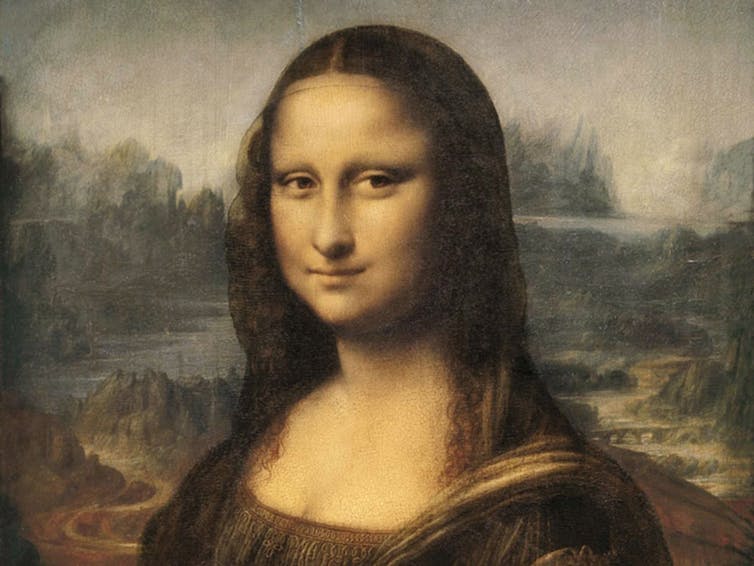
People have argued about the ‘Mona Lisa smile’ for centuries. Everett-Art via Shutterstock
For this reason, Leonardo created “ambiguous” facial expression. In ambiguous expressions there is a constant “change: of appearance, hence dynamicity. Leonardo developed the technique of "sfumato” (from the Italian word for vanishing like smoke) for this purpose. In sfumato, the transitions from bright to dark, or from one colour to another, are subtle to soften or obscure sharp edges.
This technique was not invented by Leonardo, but he further developed it and his use is unique. I agree with Alexander Nagel’s idea that Leonardo’s use of sfumato is different from any other painter/s – including from that of Andrea del Verrocchio, who was Leonardo’s teacher.
In particular, in many of Leonardo’s portraits, it is almost impossible to say when one colour ends and another starts – and this is evident in some crucial parts of his paintings, such as the mouths of his sitters. For example, the Laboratoire du Centre de Recherche et de Restauration des Musées de France, in collaboration with the European Synchrotron Radiation Facility, reported that Leonardo used up to 30 layers of varnish to achieve the subtle shading around the mouth of the La Bella Principessa (a portrait attributed to Leonardo by Martin Kemp as recently as 2011). Each of these layers was half the thickness of a human hair. The area around the mouth of the Mona Lisa has a similar level of detail.

La Bella Principessa (Recently attributed to Leonardo by Martin Kemp and thought to be from the 1490s).
My colleague, Michelle Newberry, and I suggested in 2015 that Leonardo created a sort of illusion around the mouth area in some of his portraits (for example, Mona Lisa and Bella Principessa) – from some vantage points, the sitters look content and cheerful but at other times they appear pensive or melancholic.
It is remarkable that Leonardo, creating visual illusions, played with the disagreement between the eyes and the brain centuries before scientists understood the mechanisms behind it.
Taking each discipline separately, there have undoubtedly been better artists, more important engineers or greater mathematicians. But as an individual, da Vinci was unprecedented and remains without peer – in art or science.



 The Beauty Beneath the Expressway: A Journey from Self to Service
The Beauty Beneath the Expressway: A Journey from Self to Service  Yes, government influences wages – but not just in the way you might think
Yes, government influences wages – but not just in the way you might think  Stuck in a creativity slump at work? Here are some surprising ways to get your spark back
Stuck in a creativity slump at work? Here are some surprising ways to get your spark back  Parents abused by their children often suffer in silence – specialist therapy is helping them find a voice
Parents abused by their children often suffer in silence – specialist therapy is helping them find a voice  Can your cat recognise you by scent? New study shows it’s likely
Can your cat recognise you by scent? New study shows it’s likely 










